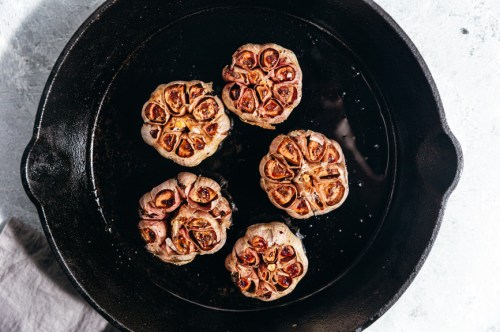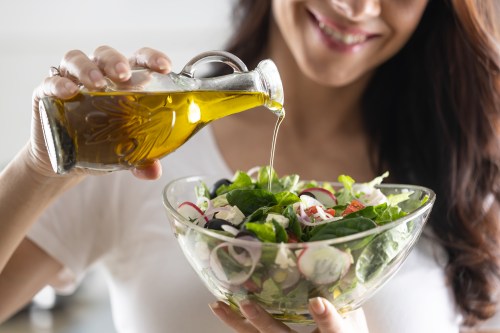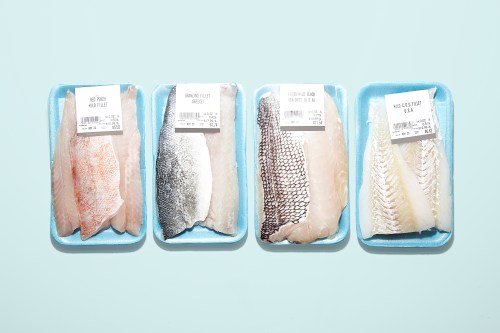Our editors independently select these products. Making a purchase through our links may earn Well+Good a commission
For most cooks, aside from salt, garlic is a quintessential ingredient in most recipes. Think shrimp scampi or 40-clove garlic chicken. But as much as you may love eating this aromatic and highly-flavorful allium, cracking open a head of garlic, let alone mincing it, can be quite the ordeal. (Read: Getting a lumpy and not-uniform garlic bulb to stand still on a flat surface is virtually impossible.)
Experts in This Article
Although there definitely isn’t just one right way of cutting garlic, we’ve honed in on several tips and tricks for making this meal prep task as effortless (and safe) as possible. Cue two cooking experts that weigh in on their best-kept garlic secrets. Spoiler alert: We have the full lowdown on how to cut garlic, as well as store it and get the pesky odor of garlic off your fingertips ahead.
First things first: How do you cut open a whole garlic bulb?
POV: You get home from the grocery store and forget to pick up the bag of pre-peeled garlic. Thankfully, your next-door neighbor spares you a trip back to the supermarket and gives you a whole head of garlic. So generous. But now you’re left with the daunting task of figuring out how in the world you cut open a whole garlic bulb. Unless, of course, you’re using it to make black garlic instead.
Aside from squeezing it in your fingers with the hope of dislodging a clove or two, Lisa Bryan of Downshiftology and the author of the bestselling cookbook Downshiftology Healthy Meal Prep, recommends taking a knife to it. Plain and simple. “Slice the top off of the garlic about a quarter of the way down to expose all of the individual garlic cloves. This technique is great for when you want to roast a whole head of garlic,” Bryan says.
Granted, this method only works if you intend on using the whole head of garlic at once—which, in most cases, the more, the merrier. (After all, garlic is an aphrodisiac.) But when prepping a delicate salad dressing that would be totally overpowered by the presence of, say, 10 raw garlic cloves, you may need to resort to plan B, aka doing it the good old-fashioned way: “I personally like to open it with my hands,” says Matthew Padilla, the culinary innovation chef of True Food Kitchen. “I peel off the other layers to expose the cluster of cloves, then I remove them one at a time as needed, and it stays fresh.”
How do you separate garlic cloves?
Of course, peeling garlic cloves with your bare hands isn’t always super easy, especially if the bulb you’re working with isn’t budging much using only the pressure of your fingertips. In this case, you may want to enact a rock-and-roll-style approach. Place the head of garlic root-side down on a flat surface, and with the palm of your hands, press, push—rock and roll—into it as if you were performing garlic CPR. This will help break the head of garlic apart and separate the cloves without peeling them. And if all else fails, microwave ‘em for a few seconds.
The next step: Do you peel garlic before cutting it?
Undeniably, the most frustrating part of working with garlic is peeling the cloves. To prep ‘em and make the process much easier, Padilla recommends soaking the garlic clove in hot water for five minutes before peeling it with a small paring knife. This helps maintain their whole shape. However, if you intend on chopping or mincing the clove, he says crushing a clove on a cutting board with the side of a knife to separate the peel and inner flesh is equally as effective. That said, this can have some implications for your kitchen knife.
Although it may not damage the strong steel per se, it may cause it to tarnish the flat side of a knife if not properly cleaned shortly after crushing it. “I always have a habit of cleaning my knife between every task, so this isn’t an issue for me,” says Padilla, invoking a chef’s number-one cooking tip.
How to cut garlic, according to the pros
Fortunately, garlic can be quite forgiving—considering that it’ll be cooked down into oblivion in most cases. So, precise knife cuts aren’t always top of mind. “Use a simple rocking motion with a chef’s knife to thinly slice it, then slice across to mince it as rough or fine as you’d like,” says Bryan. “You have a lot more control over the texture of minced garlic using a knife rather than a garlic press.”
In a professional kitchen setting, chefs use a haché knife cut to create a fine mince, according to Padilla. “We would place the middle of the blade on a board, using your non-knife hand placed on top of the end of the knife,” he says. “Then using your knife hand, rock the handle up and down through the garlic in a rapid motion,” he says. It should resemble the motion of a teeter-totter going up and down, with the center of balance over the garlic clove.
But wait, why do you cut the tip off garlic?
Although it isn’t totally necessary, Padilla suggests cutting off the base of a clove. “I cut the tip off as it has an unpleasant woody texture,” he says. This is especially pertinent if the goal is to get the many benefits of raw garlic and eat it uncooked, which doesn’t lend the tough ends an opportunity to soften up.
How can you tell if garlic has gone bad?
Did you happen to see a green stem starting to poke out of the bulb of garlic that’s been sitting on your countertop for weeks? Does this mean it’s time to bid adieu to the ingredient? Both cooking experts say not necessarily. “Sprouted garlic is totally fine to eat, though it does have a slightly different flavor—it’s a bit stronger and more bitter. If you’re using multiple garlic cloves in a recipe and a few are sprouted, I doubt anyone will even notice,” Bryan says. Although she adds that she wouldn’t recommend using sprouted garlic if it’ll be the shining star ingredient of a recipe. Meanwhile, Padilla has a similar thought process. “I typically don’t use sprouted garlic unless I’m in a pinch,” he says. “If it’s sprouted, I will cut it in half and remove the center.” This can remove some of the bitterness.
But to really tell if a head of garlic is totally bad, Padilla and Bryan recommend looking for tell-tale indicators of spoilage. “The first sign of garlic going bad is a change in color. You may start to see spots on the garlic cloves when you peel them,” Padilla says. Bryan adds that fresh garlic should be plump and firm. “Garlic that’s beyond its prime may be shriveled and soft to the touch,” she says.
What’s the best way to store garlic?
Similar to onions, Bryan says heat and moisture are garlic’s main enemies. “Keep garlic bulbs stored in your pantry or other cool, dry place so they don’t rot or sprout from any direct sunlight,” she says. According to her, this can help prolong its shelf life for weeks. As for the cloves, Bryan recommends storing them in two ways: whole or pureed. “To store whole cloves, remove the individual cloves from the head and peel them. Store them in an airtight container in the fridge for up to one week or in the freezer for up to three months,” Bryan says.
If you want easy access to already-minced cloves, Bryan suggests throwing them into a food processor and pureeing them. “Then, place them in a small ice cube tray and freeze. Once firm, transfer them to an airtight container in the freezer and store them for up to three months. Plus, you don’t need to thaw them before using them—just add them straight to whatever you’re making,” she says. Padilla also recommends submerging minced garlic in olive oil, which can also help lengthen their freshness.
How to remove garlic smell from fingers
If the smell of garlic seems to linger on your fingertips for days on end, Bryan and Padilla have a few helpful tips to mitigate the situation at hand (pun intended). “While there are many different methods—like rubbing your hands against a stainless steel pot or rubbing coffee grounds in your hands—what I do most often is rub a little salt and baking soda in my hands with a few drops of water to create a paste,” Bryan says. “Then, I’ll rinse that off with soap and water.” Padilla agrees and also suggests using a squeeze of lemon to help remove any lingering odor.
Learn the benefits of garlic, according to an RD:
Sign Up for Our Daily Newsletter
Get all the latest in wellness, trends, food, fitness, beauty, and more delivered right to your inbox.
Got it, you've been added to our email list.











